Using ABM to Study the Potential of Land Use Change for Mitigation of Food Deserts
Abstract
:1. Introduction
2. Methods: Model Development
- Human System. The human system comprises individuals and households and their decision-making and actions upon farmland use. The study used age and gender to estimate the food needs of the population in the county. These allowed us to estimate households’ fruit and vegetable needs based on the Centers for Disease Control and Prevention (CDC) daily recommendations. In this study, household agents define the human system. Therefore, household agents are minimal units for measuring human variables and include household information and land perceived by the agents, which are either farming or consumer households. A farming household is a household that decides how to use its farmlands and allocate resources at the beginning of the farming season. In contrast, a consumer household is a household with its own behavior and decision-making characteristics when it comes to consuming food items such as fresh fruits and vegetables. The food choice of each consumer household is influenced by the type of crops that the farming household grows. The main attributes of households include human, physical, and natural-related factors. Each individual who belongs to the household is defined by their age, gender, income, and educational status. The household’s agent structure is described as:where, is a set of household information including individual variables; is the spatial information obtained from lands, such as plot land size; is behavioral parameters that the households or individuals use to make decisions; Rules are a set of conditions that define a logical procedure driven to decide how households use their land parcels. It represents the Decision-making mechanism that takes inputs from the household’s background and land parcels, assuming that household agents behave reactively according to the rules. A procedure of decision-making is universal for all household agents concerning its logical sequence. However, decision outcomes are diverse since the agent’s state, parameters, and structure of utility functions are individual-specific. The household background included the following attributes as mentioned before:where, represents the human resources based on their age and gender, is the available land, represents farm landowners’ capital, is policy related to households and their land uses, represents households size, and is the educational status of landowners or households.
- Natural System. The natural system is the landscape with its attributes and ecological response mechanisms to environmental changes and human interventions (Figure 1). The study selected the main natural system-related factors contributing to a food desert based on literature and data availability. These include landscape, temperature, soil quality, and precipitation. For example, temperature and precipitation variability adversely affect the quality and quantities of crop production. In addition, soil quality also has a significant impact on crop production. In this study, land agents define the natural system. A land agent is a spatial unit for measuring spatial variables of a landscape corresponding to a parcel map, such as land cover and property boundaries.Land size is the total available farmland used by farmers to produce fruits and vegetables needed to meet the food requirements. Since the unavailability of enough land for crop production causes a shortage of healthy foods, the model makes a land-use transition to minimize the issue. In this case, the land-use change is made by considering regional and federal land use policies, Climate variability, and Soil quality. For example, since temperature and precipitation affect the crops’ planting, growing, and harvesting processes, the model considers these factors to estimate the size of croplands needed to meet the food requirements and the amount of crop yields obtained from the farmlands. Soil is another essential element of thriving agriculture and is the primary source of nutrients used to grow crops [51]. Soil quality affects the quality and quantity of crop production. Farmlands with relatively healthy soils produce healthy and high amounts of fruits and vegetables. Based on that context, the fruit and vegetable yields obtained per acre of land can be estimated by considering the land’s soil quality. The decision is based on the agents’ expected yields, land availability, and the fruit and vegetable needs of the community. Therefore, food needs are considered by simultaneously optimizing the production and consumption decisions. Note that landscape, temperature, soil, and precipitation are selected for the natural system based on literature and availability of data.
- The interaction of human and natural systems. The human and natural systems’ interactions drive land-use changes critical for global processes such as climate change and food shortage. The human system impacts natural systems, whereas natural systems present food production conditions to the human system. The human system affects the natural environment in many ways, including pollution and deforestation. These changes have resulted in climate change and a shortage of rainfall that have led to food insecurity [52]. In this research, through our ABM model, we study the interaction between these two systems and farmland-use transition in response to human decisions and natural constraints to improve food deserts. This interaction can be between human agents or human–natural agents. For example, the interaction between human and natural agents can affect the quality and quantity of farmland’s crop yields. Natural agent attributes such as temperature, rainfall availability, and soil quality affect the farm’s crop productivity. The ABM model can simulate this interaction and show possible solutions to increase crop production by implementing land-use changes. The land-use changes can allow the use of more farmlands to increase crop yields when there is not enough rainfall, temperature, and the soil quality of the farmland is not good.
3. Data Processing
3.1. Study Area
3.2. Research Data
- Annual rainfall and temperature data. Annual precipitations and temperature data for the study area were downloaded from the U.S. Geological Survey (USGS) website (https://waterdata.usgs.gov/nc/nwis/annual/?referred_module=sw (accessed on 8 June 2021)) and National Oceanic and Atmospheric Administration (NOAA) website (https://www.ncdc.noaa.gov/cdo-web/ (accessed on 2 June 2021)). The precipitation record comes from human-facilitated and automated observation stations in the Global Historical Climatology Network-Daily database. The study used the annual rainfall and temperature data from the year 2011 to 2020 for model development purposes.
- Cropland Data Layer (CDL) data. The CDL land cover raster was downloaded from the USDA website (https://nassgeodata.gmu.edu/CropScape/ (accessed on 26 June 2021)). CDL is a publicly available land cover classification map covering 48 states in the U.S. at 30 m resolution. The study used the CDL raster from 2011 to 2020 for land cover analysis purposes.
- Parcel data. The parcel data has information about Guildford County property ownership. The data was downloaded from the NC OneMap website (https://www.nconemap.gov/ (accessed on 15 July 2021)).
- Household data. The household data for Guilford County was downloaded from the USDA Economic Research Service website (https://www.ers.usda.gov/data-products/food-access-research-atlas/ (accessed on 12 June 2021)). The Food Access Research Atlas has an overview of food access factors for low-income and other census tracts using various measures of supermarket accessibility. It also provides food access data for populations within census tracts. The study used this data to create a food desert map of Guilford County. This study also used household information such as an individual’s gender and age to estimate the total food requirement of a specific area since individual daily fruit and vegetable needs depend on them. In addition, since we use an ABM, a bottom-up strategy, data containing the spatial distribution of households and their characteristics in our study area are used for model development.
- Soil data layer. This layer displays the National Commodity Crop Productivity Index (NCCPI) derived from the Soil Survey Geographic Database (SSURGO). SSURGO is generally the detailed level of soil geographic data prepared by the National Cooperative Soil Survey (NCSS) in accordance with the NCSS mapping standards. The soil quality data ranks the inherent capability of soils for crop production and other applications. This data was downloaded for our study area from the NCCPI in ArcGIS online (https://landscape11.arcgis.com/arcgis/ (accessed on 15 July 2021)). This map has 30 m pixel size and, combining this layer with other information, is used to measure soil suitability for crop production in this study.
- Population growth rate data. The population growth data was collected for Guilford County, North Carolina, from 2011 to 2020 as input for the ABM development. This data was used to estimate the seasonal fruit and vegetable needs of Guilford County. The data was downloaded from the United States Census Bureau website (https://www.census.gov/data.html (accessed on 15 June 2021)).
3.3. Data Processing
- CDL Data Reclassification. The study reclassified the CDL maps of Guilford County downloaded from the USDA website from 2019 to 2020 to use them as input for the ABM development. The CDL map layers have more than 120 individual classes, including apple, carrot, orange, cabbage, etc. The reclassification is done to group all types of fruit together as one class, “fruit”. The same regrouping process is done to combine all vegetables as one “vegetable” class [57]. Based on that context, each season, CDL’s farmlands (from 2011 to 2020) were regrouped into eight categories: (1) vegetable, (2) fallow, (3) fruit, (4) row crop, (5) hay, (6) forest, (7) barren, and (8) wetlands.
- Georeferencing and Resampling the Data. In this study, we clipped the Guilford County CDL raster layer from the North Carolina CDL map for further analysis. In addition, the raster data used in the study were georeferenced for geospatial data integration and visualization purposes.
- Precipitation, temperature, and slope maps preparation. Temperature and rainfall raster maps were generated to understand their effects in Guilford County. We used point temperature and rainfall data to create these spatially distributed heat maps using the Kriging interpolation method with a 30 m pixel resolution. Kriging is a geostatistical procedure that creates an estimated surface from a scattered set of points with values. The slope map for the study area was also created using the interpolation method to understand the nature of the study area’s land for farming.
- Relation of land use with food desert indictors. In this stage, the precipitation map is overlaid with the CDL land cover map of Guilford County to study the correlations between them. The land coverage area of fruit, vegetables, row crops, and hay in the study area is calculated considering the magnitude of precipitation from place to place. The same procedure was followed to study the correlation between land use and the temperature, soil quality, and slope of the study area.
3.4. Model Development
- Households. This study used household information to estimate the total food requirement of a specific area since individual daily fruit and vegetable needs depend on them. In the ABM, one household is represented by one agent. It can follow specific rules and make land-use and other decisions based on household-specific data. The food requirement of the community is based on each individual’s needs in the household. During each season time step of the model, farming households went through resource allocation, planting, and harvesting processes. The ABM model runs through 20 farming seasons from 2019 to 2030.
- Farmlands This study used available farmlands in Guilford County for ABM development. In the ABM, one patch of farmland is represented by an agent. This agent follows specific rules and interacts with other agents such as households. The research estimated the county’s annual fruit and vegetable productions from 2011 through 2020 to better understand the correlation between healthy food production and food desert areas in the study area. The production increase or land-use transition recommendation for the future years can be made by considering the county’s population, population growth rate, and the availability of land.
- Seasonal fruit and vegetable needs. Individuals’ daily fruit and vegetable needs vary by age and gender. Adults should consume from 1.5 to 2 cups equivalents of fruits and from 2 to 3 cup-equivalents of vegetables daily, according to the 2020–2025 Dietary Guidelines for Americans. The prevalence of meeting fruit intake recommendations was highest among adults aged ≥51 years (12.5%) and lowest among those living below or close to the poverty level (income to poverty ratio [IPR] < 1.25) (6.8%) (https://www.cdc.gov/mmwr/volumes/71/wr/mm7101a1.htm#suggestedcitation (accessed on 7 January 2022)). Only 9% and 12% of adults ate the recommended amount of vegetables and fruit, respectively, according to a CDC analysis of data from the 2015 Behavioral Risk Factor Surveillance System (https://www.cdc.gov/nccdphp/dnpao/division-information/media-tools/adults-fruits-vegetables.html (accessed on 16 February 2021)). The total daily fruit and vegetable intake is calculated using individuals’ age and gender information based on CDC daily fruit and vegetable intake recommendations at the start of a farming season. This study assumed that people eat fruits and vegetables five days a week; thus, the individual yearly needs are calculated based on Equation (4). This allowed us to estimate the size of land parcels needed to meet the fruit and vegetable requirements.Note that this study hypothesizes increasing fruit and vegetable production can minimize the issue of a food desert mainly if local farmers use their fruits and vegetable production to meet their family food needs and locally sell them. Therefore, we have not included the food import or export in the estimations.
- Land-use policies. Federal and state land-use-related policies have a significant impact on crop production. In addition, environmental effects and demands for other outputs (e.g., hay, trees, cash crops, etc.) significantly impact land use changes and crop production. For example, the conversion of forest land into farmland can lead to ecological effects (e.g., effects on the quality of water and wildlife habitat) and socioeconomic effects (e.g., reduction of forest recreation opportunities, reduction of long-term timber production, and loss of open space) as significant implications of forest loss [58]. In addition, farmers may not be interested in using their cash crops, hay, or other land parcels to plant fruits and vegetables for personal use. Instead, they grow cash crops for sale [59] and use their profit to pay their taxes and hire agricultural laborers. In this study, vegetation and wetlands are not recommended to convert to croplands. Based on that context, the land transition in this study is completed to meet the fruit and vegetable requirements of the county from fallow or/and hay lands to fruit or/and vegetable lands.
- Population growth rate. Population growth is one of the factors that can drive up demand for food, which typically requires land-use transition to meet the needs. Increases in land dedicated to agricultural purposes may help meet the food demand increased due to population growth. Figure 6 shows the population growth rate of Guilford County from 2011 to 2020. The population growth rate data is used in this study to calculate the seasonal fruit and vegetable needs of Guilford County for each season (Figure 6).
- Climate variability and soil quality. Climate change and soil quality degradation are ongoing problems growing exponentially over the globe as the composition of the atmosphere changes. In North Carolina, the climate has shifted; as a result, the average temperature has increased, and droughts and floods have become more frequent. The production of crops and other agricultural products is impacted by the increasing temperature, precipitation shortage, and soil quality degradation. Depending on the crop types, an increase in average temperature and precipitation may help to increase agricultural production. However, extreme temperatures and precipitation can prevent crops from growing. Therefore, the optimum temperature and precipitation need to be identified for the study area to know their impacts on crop production in the simulation model. The optimum temperature is a temperature suitable for producing crops. Therefore, investigating the relationship between crop yield and climate variability (mainly temperature and precipitation) is essential for predicting agricultural land-use decisions with climate change to understand its impacts on crop yields. Once the county’s seasonal fruit and vegetable requirements for each season are known, the size of farmlands needed to fulfill the vegetable and fruit requirements has to be calculated for each season in terms of suitable temperature, precipitation, and soil quality. For example, suppose the existing fruit and vegetable lands are insufficient to grow the required fruits and vegetables. The model transforms the land cover from fallow and hay to fruits and vegetables in that case. Land-use transition decisions are made by the rainfall, temperature availability, and soil quality of the area. For example, when there is enough rainfall and temperature in the season, the model assumes households can plant and harvest effectively and get more productional outputs since the agricultural production outputs depend on their availability and soil quality. On the other hand, if the season with temperature or rainfall is not optimum (too high or too low), the fruit and vegetable yield will be low, and more land will be involved in the transition to meet the crop requirements of the season. Therefore, the land size to meet the yearly food needs in the county depends on the climate conditions (temperature, rainfall), soil quality, and the population growth rate.
- Crop yield. Once the impacts of climate variability and soil quality are known, the study area’s fruit and vegetable yields are estimated for each season. Crop yield is the main component used in determining overall production and supply. Crop yield is defined as the standard measurement of the amount of agricultural output obtained per unit of land area. One of the standard units of yield measurement is tons per acre in the United States. The average crop yield is estimated using the following formula:where Ln is the number of available patch lands in Guilford County, K represents the parameter for precipitation, temperature, and soil quality impacts on crop yields. The value of 10,000 is the average estimated crop yield in pounds (lb) per acre of land [60,61]. Finally, the total land size needs to meet the fruit and vegetable requirements of the county for each season calculated by dividing the yearly crop needs of the county by crop yields per 1 acre of land estimation value.
4. Results and Discussions
4.1. Model Development
4.1.1. Land Use Relation with Land Productivity and Slope
4.1.2. Land Use Relation with Climate Variability
4.2. Simulation Results
5. Conclusions
Author Contributions
Funding
Institutional Review Board Statement
Informed Consent Statement
Data Availability Statement
Conflicts of Interest
References
- Brown, C.; Miller, S. The Impacts of Local Markets: A Review of Research on Farmers Markets and Community Supported Agriculture (CSA). Am. J. Agric. Econ. 2008, 90, 1296–1302. [Google Scholar] [CrossRef]
- Onyango, B.M.; Hallman, W.K.; Bellows, A.C. Purchasing organic food in U.S. food systems: A study of attitudes and practice. Br. Food J. 2007, 109, 399–411. [Google Scholar] [CrossRef] [Green Version]
- Schnell, S.M. Food with a ffarmer’sface: Community-supported agriculture in the United States. Geogr. Rev. 2007, 97, 550–564. [Google Scholar] [CrossRef]
- Bentsen, K.; Pedersen, P.E. Consumers in local food markets: From adoption to market co-creation? Br. Food J. 2020, 123, 1083–1102. [Google Scholar] [CrossRef]
- Liang, C.-L.; Kurkalova, L.; Beni, L.H.; Mulrooney, T.; Jha, M.; Miao, H.; Monty, G. Introducing an innovative design to examine human-environment dynamics of food deserts responding to COVID-19. J. Agric. Food Syst. Community Dev. 2021, 10, 123–133. [Google Scholar] [CrossRef]
- Lele, U.; Klousia-Marquis, M.; Goswami, S. Good Governance for Food, Water and Energy Security. Aquat. Procedia 2013, 1, 44–63. [Google Scholar] [CrossRef]
- Termeer, C.J.; Drimie, S.; Ingram, J.; Pereira, L.; Whittingham, M.J. A diagnostic framework for food system governance arrangements: The case of South Africa. NJAS—Wagening. J. Life Sci. 2018, 84, 85–93. [Google Scholar] [CrossRef]
- Hendrickson, D.; Smith, C.; Eikenberry, N. Fruit and vegetable access in four low-income food deserts communities in Minnesota. Agric. Hum. Values 2006, 23, 371–383. [Google Scholar] [CrossRef]
- Bitler, M.; Steven, J.H. An economic view of food deserts in the United States. J. Policy Anal. Manag. 2011, 30, 153–176. [Google Scholar]
- Leschewski, A.M.; Weatherspoon, D.D. Fast food restaurant pricing strategies in Michigan food deserts. Int. Food Agribus. Manag. Rev. 2014, 17, 147–170. [Google Scholar]
- Hake, M.; Engelhard, E.; Dewey, A.; Gundersen, C. The Impact of the Coronavirus on Child Food Insecurity; Feeding America: Chicago, IL, USA, 2020. [Google Scholar]
- Lewis, E.C.; Colón-Ramos, U.; Gittelsohn, J.; Clay, L. Food-seeking behaviors and food insecurity risk during the Coronavirus disease 2019 pandemic. J. Nutr. Educ. Behav. 2022, 54, 159–171. [Google Scholar] [CrossRef]
- Ploeg, M.V.; Dutko, P.; Breneman, V. Measuring Food Access and Food Deserts for Policy Purposes. Appl. Econ. Perspect. Policy 2015, 37, 205–225. [Google Scholar] [CrossRef] [Green Version]
- McGuire, S.; FAO; IFAD; WFP. The state of food insecurity in the world 2015: Meeting the 2015 international hunger targets: Taking stock of uneven progress. Adv. Nutr. 2015, 6, 623–624. [Google Scholar] [CrossRef] [Green Version]
- USDA. Food Security and Nutrition Assistance. 2020. Available online: https://www.ers.usda.gov/data-products/ag-and-food-statistics-charting-the-essentials/food-security-and-nutrition-assistance/?topicId=c40bd422-99d8-4715-93fa-f1f7674be78b (accessed on 24 April 2020).
- Neuhouser, M.L. The importance of healthy dietary patterns in chronic disease prevention. Nutr. Res. 2019, 70, 3–6. [Google Scholar] [CrossRef]
- Kelli, H.M.; Kim, J.H.; Tahhan, A.S.; Liu, C.; Ko, Y.; Hammadah, M.; Sullivan, S.; Sandesara, P.; Alkhoder, A.A.; Choudhary, F.K.; et al. Living in Food Deserts and Adverse Cardiovascular Outcomes in Patients with Cardiovascular Disease. J. Am. Hear. Assoc. 2019, 8, e010694. [Google Scholar] [CrossRef] [Green Version]
- Testa, A.; Jackson, D.B.; Semenza, D.C.; Vaughn, M.G. Food deserts and cardiovascular health among young adults. Public Health Nutr. 2021, 24, 117–124. [Google Scholar] [CrossRef]
- Dubowitz, T.; Ncube, C.; Leuschner, K.; Tharp-Gilliam, S. A natural experiment opportunity in two low-income urban food desert communities: Research design, community engagement methods, and baseline results. Health Educ. Behav. 2015, 42 (Suppl. S1), 87S–96S. [Google Scholar] [CrossRef] [Green Version]
- Ghosh-Dastidar, M.; Hunter, G.; Collins, R.L.; Zenk, S.N.; Cummins, S.; Beckman, R.; Nugroho, A.K.; Sloan, J.C.; Wagner, L.; Dubowitz, T. Does opening a supermarket in a food desert change the food environment? Health Place 2017, 46, 249–256. [Google Scholar] [CrossRef] [PubMed]
- Masipa, T.S. The impact of climate change on food security in South Africa: Current realities and challenges ahead. Jàmbá J. Disaster Risk Stud. 2017, 9, 7. [Google Scholar] [CrossRef] [Green Version]
- Ray, D.K.; Gerber, J.S.; MacDonald, G.K.; West, P.C. Climate variation explains a third of global crop yield variability. Nat. Commun. 2015, 6, 5989. [Google Scholar] [CrossRef] [Green Version]
- Matiu, M.; Ankerst, D.P.; Menzel, A. Interactions between temperature and drought in global and regional crop yield variability during 1961–2014. PLoS ONE 2017, 12, e0178339. [Google Scholar] [CrossRef] [PubMed] [Green Version]
- George, D.R.; Kraschnewski, J.L.; Rovniak, L.S. Public health potential of farmers’ markets on medical center campuses: A case study from Penn State Milton S. Hershey Medical Center. Am. J. Public Health 2011, 101, 2226–2232. [Google Scholar] [CrossRef] [PubMed]
- Rimal, B.; Zhang, L.; Keshtkar, H.; Wang, N.; Lin, Y. Monitoring and Modeling of Spatiotemporal Urban Expansion and Land-Use/Land-Cover Change Using Integrated Markov Chain Cellular Automata Model. ISPRS Int. J. Geo-Inf. 2017, 6, 288. [Google Scholar] [CrossRef] [Green Version]
- Azubike, C.S.; Kurkalova, L.A.; Mulrooney, T.J. Modeling Land Use and Land Cover in North Carolina; a Markov Chain Approach. In Proceedings of the 2019 Annual Meeting, Atlanta, GA, USA, 21–23 July 2019. [Google Scholar]
- Liu, X.; Liang, X.; Li, X.; Xu, X.; Ou, J.; Chen, Y.; Li, S.; Wang, S.; Pei, F. A future land use simulation model (FLUS) for simulating multiple land use scenarios by coupling human and natural effects. Landsc. Urban Plan. 2017, 168, 94–116. [Google Scholar] [CrossRef]
- Lambin, E.F.; Geist, H.J.; Lepers, E. Dynamics of Land-Use and Land-Cover Change in Tropical Regions. Annu. Rev. Environ. Resour. 2003, 28, 205–241. [Google Scholar] [CrossRef] [Green Version]
- Jiao, W.; Zhang, L.; Chang, Q.; Fu, D.; Cen, Y.; Tong, Q. Evaluating an Enhanced Vegetation Condition Index (VCI) Based on VIUPD for Drought Monitoring in the Continental United States. Remote Sens. 2016, 8, 224. [Google Scholar] [CrossRef] [Green Version]
- Rahman, S.; Di, L.; Yu, E.; Lin, L.; Yu, Z. Remote Sensing Based Rapid Assessment of Flood Crop Damage Using Novel Disaster Vegetation Damage Index (DVDI). Int. J. Disaster Risk Sci. 2021, 12, 90–110. [Google Scholar] [CrossRef]
- Zhang, R.; Tang, C.; Ma, S.; Yuan, H.; Gao, L.; Fan, W. Using Markov chains to analyze changes in wetland trends in arid Yinchuan Plain, China. Math. Comput. Model. 2011, 54, 924–930. [Google Scholar] [CrossRef]
- Ding, Z.; Gong, W.; Li, S.; Wu, Z. System dynamics versus agent-based modeling: A review of complexity simulation in construction waste management. Sustainability 2018, 10, 2484. [Google Scholar] [CrossRef] [Green Version]
- Zhu, Y.; Diao, M.; Ferreira, J.; Zegras, C. An integrated microsimulation approach to land-use and mobility modeling. J. Transp. Land Use 2018, 11, 633–659. [Google Scholar] [CrossRef]
- Verburg, P.H.; Alexander, P.; Evans, T.; Magliocca, N.R.; Malek, Z.; DA Rounsevell, M.; van Vliet, J. Beyond land cover change: Towards a new generation of land use models. Curr. Opin. Environ. Sustain. 2019, 38, 77–85. [Google Scholar] [CrossRef]
- Dadhich, P.N.; Hanaoka, S. Remote sensing, GIS and MMarkov’smethod for land use change detection and prediction of Jaipur district. J. Geomat. 2010, 4, 9–15. [Google Scholar]
- Sang, L.; Zhang, C.; Yang, J.; Zhu, D.; Yun, W. Simulation of land use spatial pattern of towns and villages based on CA—Markov model. Math. Comput. Model. 2011, 54, 938–943. [Google Scholar] [CrossRef]
- El-Hallaq, M.A.; Habboub, M.O. Using cellular automata-Markov analysis and multi criteria evaluation for predicting the shape of the Dead Sea. Adv. Remote Sens. 2015, 4, 83. [Google Scholar] [CrossRef] [Green Version]
- Moeckel, R.; Schürmann, C.; Wegener, M. Microsimulation of urban land use. In Proceedings of the 42nd European Congress of the Regional Science Association, Dortmund, Germany, 27–31 August 2002; pp. 27–31. [Google Scholar]
- Natalini, D.; Bravo, G.; Jones, A.W. Global food security and food riots—An agent-based modelling approach. Food Secur. 2019, 11, 1153–1173. [Google Scholar] [CrossRef]
- Namany, S.; Govindan, R.; Al-Fagih, L.; McKay, G.; Al-Ansari, T. Sustainable food security decision-making: An agent-based modelling approach. J. Clean. Prod. 2020, 255, 120296. [Google Scholar] [CrossRef]
- Wossen, T.; Berger, T. Climate variability, food security and poverty: Agent-based assessment of policy options for farm households in Northern Ghana. Environ. Sci. Policy 2015, 47, 95–107. [Google Scholar] [CrossRef]
- Alghais, N.; Pullar, D. Modelling future impacts of urban development in Kuwait with the use of ABM and GIS. Trans. GIS 2018, 22, 20–42. [Google Scholar] [CrossRef]
- Rounsevell, M.D.; Pedroli, B.; Erb, K.-H.; Gramberger, M.; Busck, A.G.; Haberl, H.; Kristensen, S.; Kuemmerle, T.; Lavorel, S.; Lindner, M.; et al. Challenges for land system science. Land Use Policy 2012, 29, 899–910. [Google Scholar] [CrossRef]
- Huber, R.; Bakker, M.; Balmann, A.; Berger, T.; Bithell, M.; Brown, C.; Grêt-Regamey, A.; Xiong, H.; Le, Q.B.; Mack, G.; et al. Representation of decision-making in European agricultural agent-based models. Agric. Syst. 2018, 167, 143–160. [Google Scholar] [CrossRef] [Green Version]
- Heckbert, S.; Baynes, T.; Reeson, A. Agent-based modeling in ecological economics. Ann. N. Y. Acad. Sci. 2010, 1185, 39–53. [Google Scholar] [CrossRef] [PubMed]
- Sun, Z.; Lorscheid, I.; Millington, J.D.; Lauf, S.; Magliocca, N.R.; Groeneveld, J.; Balbi, S.; Nolzen, H.; Müller, B.; Schulze, J.; et al. Simple or complicated agent-based models? A complicated issue. Environ. Model. Softw. 2016, 86, 56–67. [Google Scholar] [CrossRef] [Green Version]
- Dai, E.; Ma, L.; Yang, W.; Wang, Y.; Yin, L.; Tong, M. Agent-based model of land system: Theory, application and modelling framework. J. Geogr. Sci. 2020, 30, 1555–1570. [Google Scholar] [CrossRef]
- Auchincloss, A.H.; Garcia, L.M.T. Brief introductory guide to agent-based modeling and an illustration from urban health research. Cad. Saude Publica 2015, 31, 65–78. [Google Scholar] [CrossRef] [PubMed] [Green Version]
- Gebrehiwot, A.; Beni, L.H.; Kurkalova, L.A.; Liang, C.L.; Jha, M.K.; Mulrooney, T.J.; Dhamankar, S. Agent Based Modeling of Land Use and Land Cover Changes to Assess Community Food Desert Using Geospatial Technology. In Proceedings of the AGU Fall Meeting 2021, New Orleans, LA, USA, 13–17 December 2021. [Google Scholar]
- Dhamankar, S.; Beni, L.H.; Kurkalova, L.A.; Jha, M.K.; Liang, C.L.; Mulrooney, T.J.; Monty, G.; Gebrehiwot, A. Geospatial Data Analysis to Understand Food Security. In Proceedings of the AGU Fall Meeting 2021, New Orleans, LA, USA, 13–17 December 2021. [Google Scholar]
- Demir, Z.; Tursun, N.; Işık, D. Effects of different cover crops on soil quality parameters and yield in an apricot orchard. Int. J. Agric. Biol. 2019, 21, 399–408. [Google Scholar]
- Goudie, A.S. Human Impact on the Natural Environment, 8th ed.; John Wiley & Sons: Hoboken, NJ, USA, 2018. [Google Scholar]
- Guan, C.; Rowe, P.G. Should big cities grow? Scenario-based cellular automata urban growth modeling and policy applications. J. Urban Manag. 2016, 5, 65–78. [Google Scholar] [CrossRef]
- Mulrooney, T.; Foster, R.; Jha, M.; Beni, L.H.; Kurkalova, L.; Liang, C.L.; Miao, H.; Monty, G. Using geospatial networking tools to optimize source locations as applied to the study of food availability: A study in Guilford County, North Carolina. Appl. Geogr. 2021, 128, 102415. [Google Scholar] [CrossRef]
- Baumhardt, R.L.; Stewart, B.A.; Sainju, U.M. North American Soil Degradation: Processes, Practices, and Mitigating Strategies. Sustainability 2015, 7, 2936–2960. [Google Scholar] [CrossRef] [Green Version]
- Smith, G.; Archer, R.; Nandwani, D.; Li, J. Impacts of urbanization: Diversity and the symbiotic relationships of rural, urban, and spaces in-between. Int. J. Sustain. Dev. World Ecol. 2018, 25, 276–289. [Google Scholar] [CrossRef]
- Kurkalova, L.A.; Beni, L.H.; Liang, C.-L. Vegetable production: Land use perspective. In Proceedings of the Elected Poster: AAEA Annual Meeting, Austin, TX, USA, 1–3 August 2021. [Google Scholar]
- Kim, T.J.; Wear, D.N.; Coulston, J.; Li, R. Forest land use responses to wood product markets. For. Policy Econ. 2018, 93, 45–52. [Google Scholar] [CrossRef]
- Schneider, K.; Gugerty, M.K. The impact of export-driven cash crops on smallholder households. Gates Open Res. 2019, 3, 1379. [Google Scholar]
- Schreinemachers, P. The (Ir) Relevance of the Crop Yield Gap Concept to Food Security in Developing Countries; Cuvillier Verlag: Göttingen, Germany, 2006. [Google Scholar]
- Juma, G.S.; Beru, F.K. Prediction of Crop Yields under a Changing Climate. In Agrometeorology; BoD—Books on Demand: Norderstedt, Germany, 2021. [Google Scholar]
- Bandaru, V.; Izaurralde, R.; Manowitz, D.; Link, R.; Zhang, X.; Post, W.M. Soil Carbon Change and Net Energy Associated with Biofuel Production on Marginal Lands: A Regional Modeling Perspective. J. Environ. Qual. 2013, 42, 1802–1814. [Google Scholar] [CrossRef]
- Ralph, E.N. Growing Season Characteristics and Requirements in the Corn Belt; Purdue University: West Lafayette, IN, USA, 2019; Available online: https://mdc.itap.purdue.edu/item.asp?itemID=20092 (accessed on 23 May 1990).
- Ritchie, I. Precipitation Impact on Crop Yield. Bachelor’s Thesis, University of Nebraska-Lincoln, Lincoln, NE, USA, 2021. [Google Scholar]
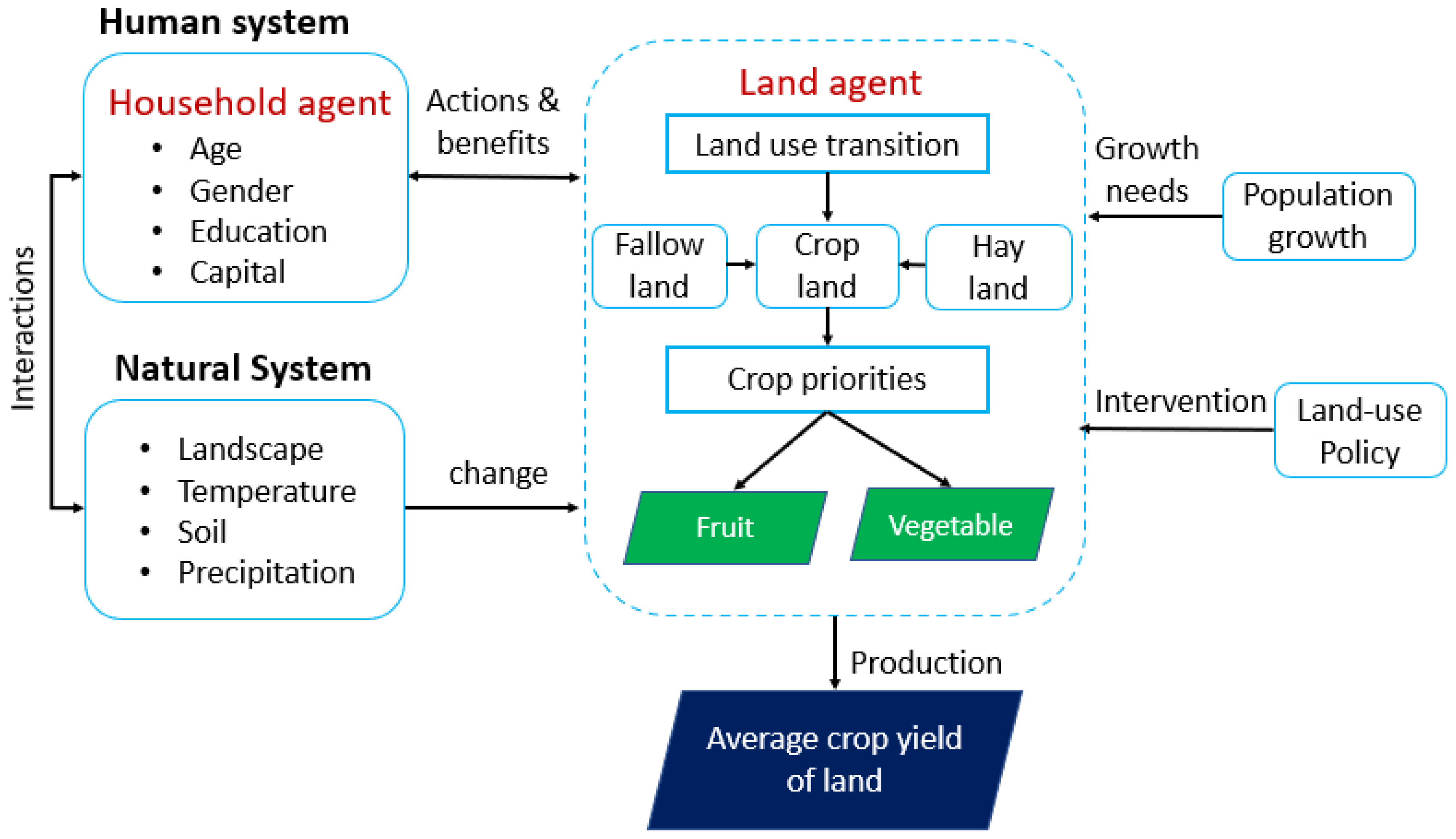
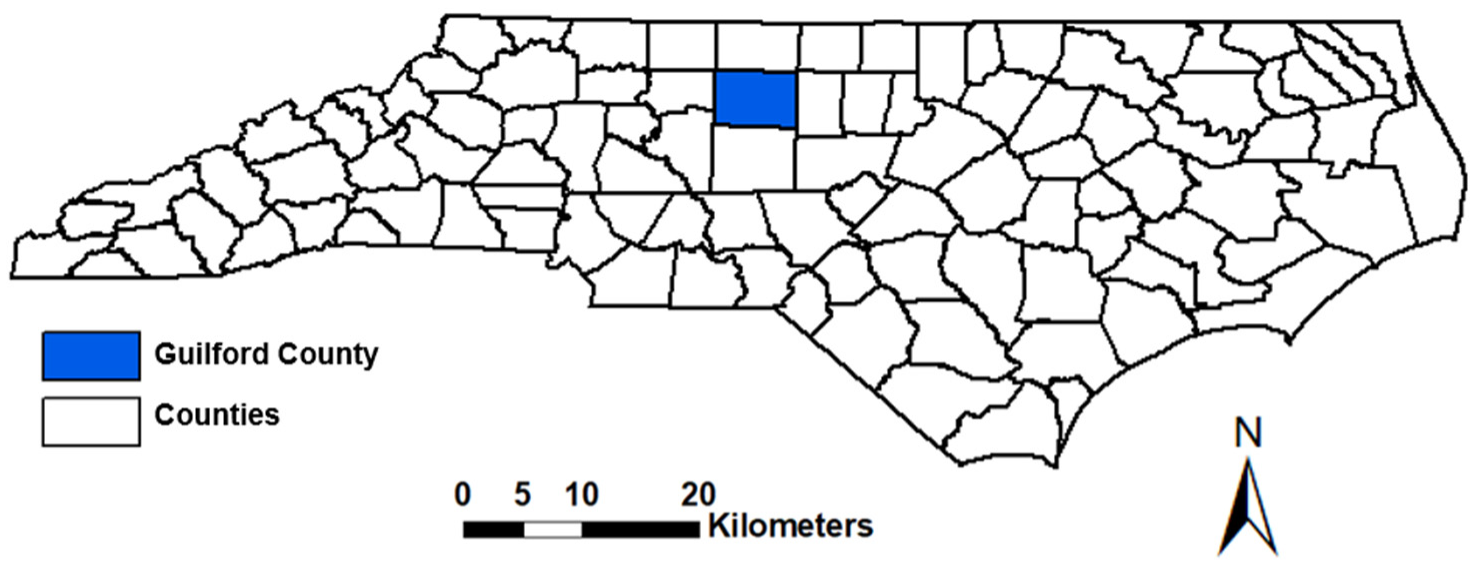
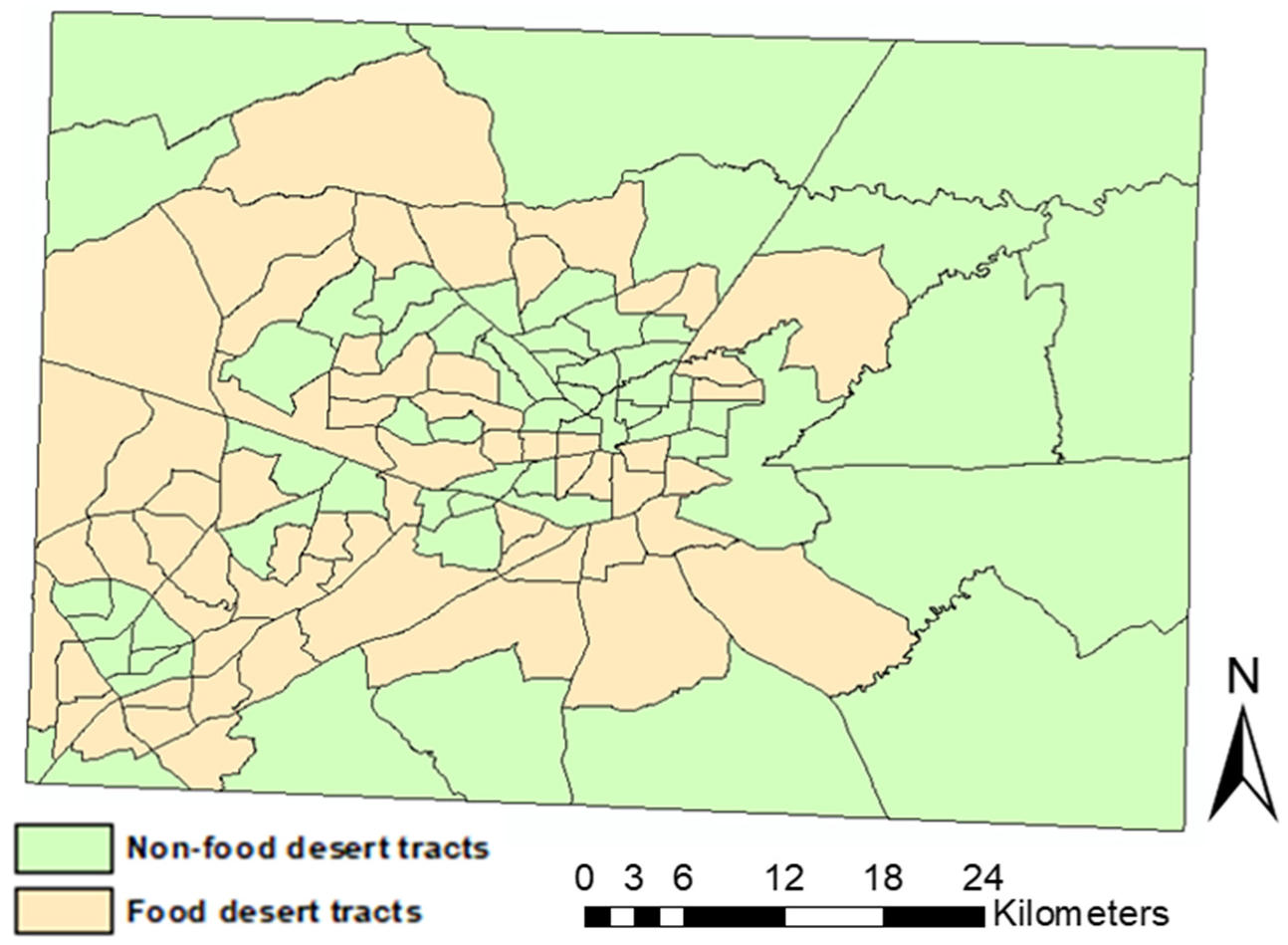
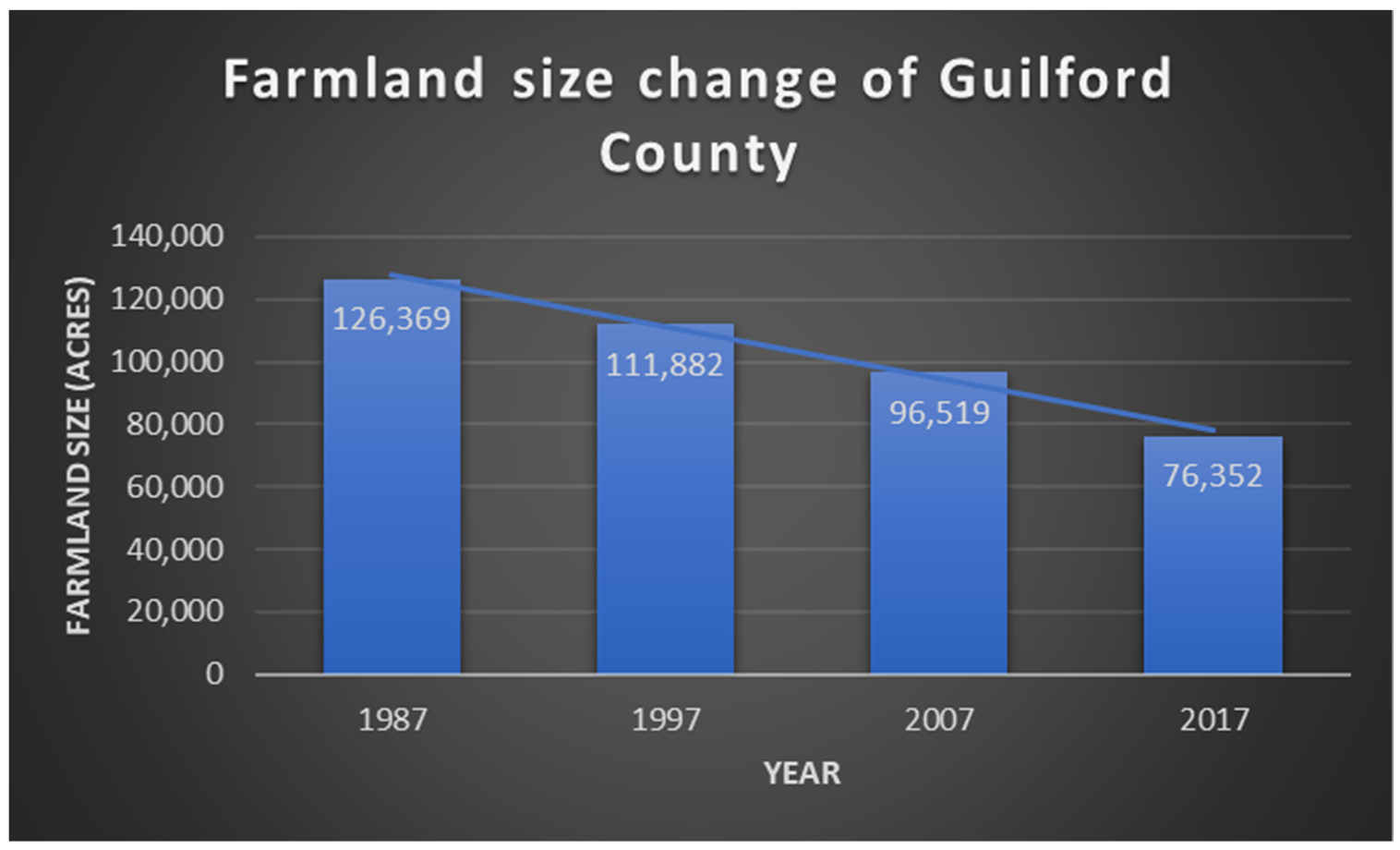
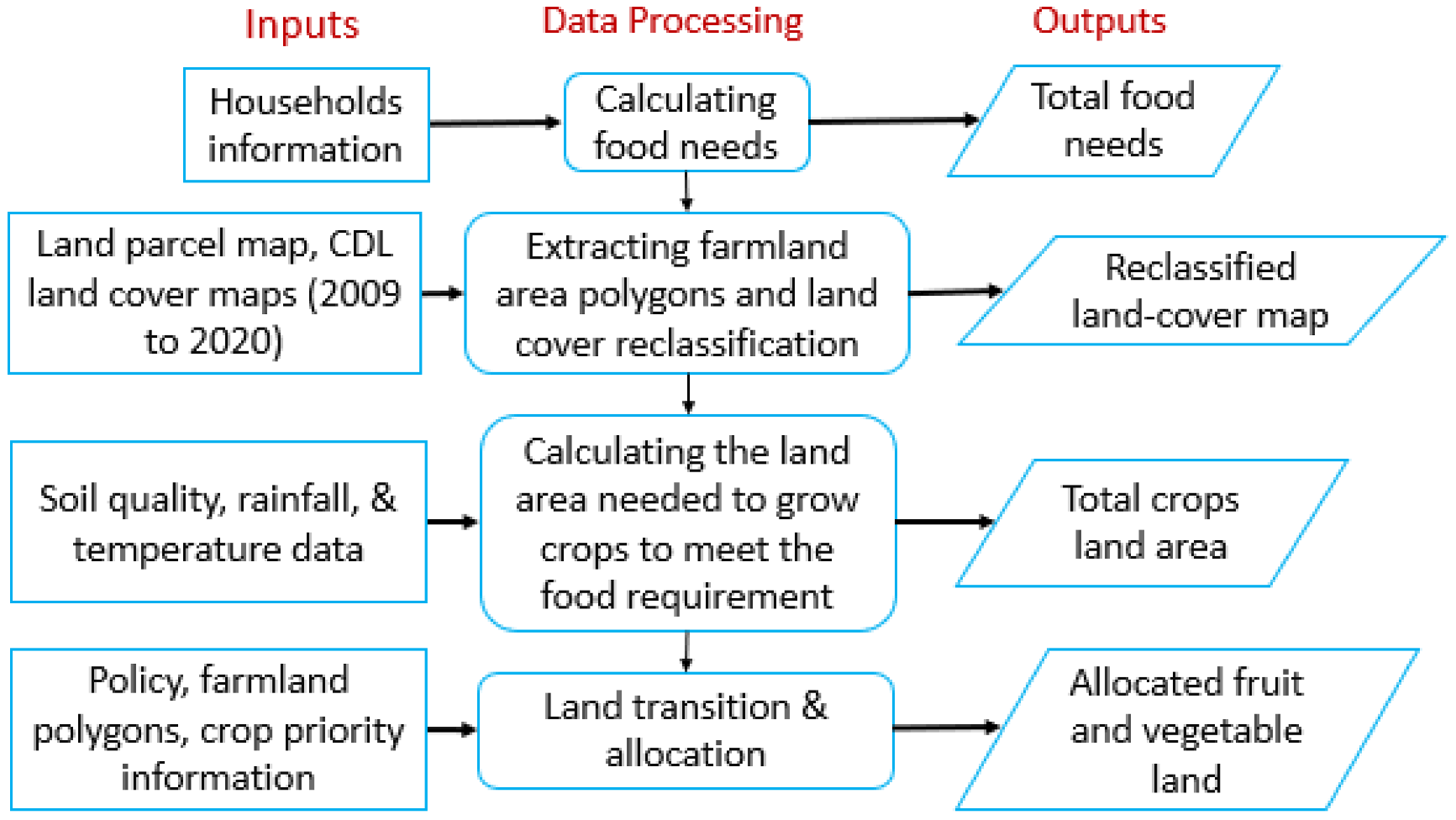
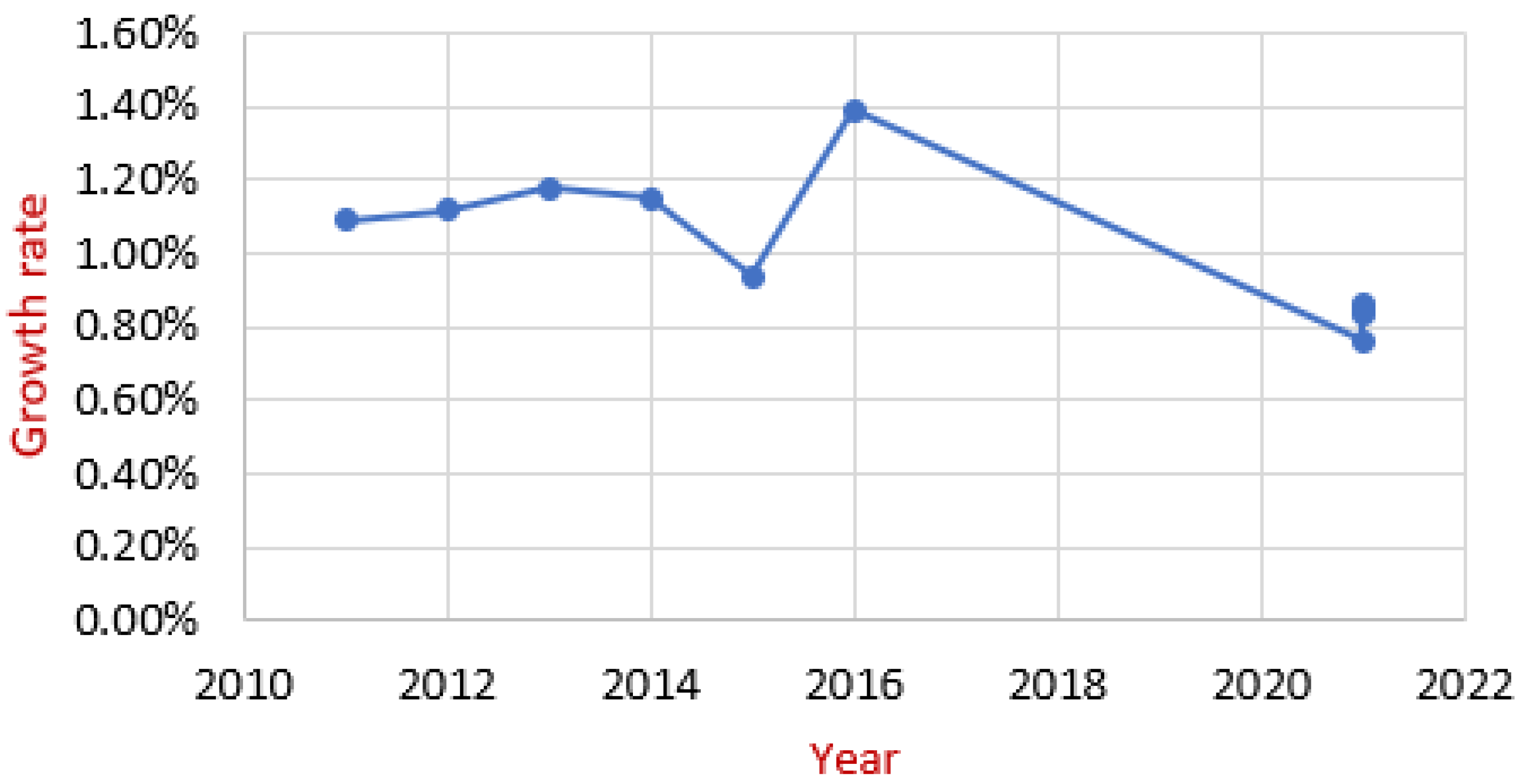
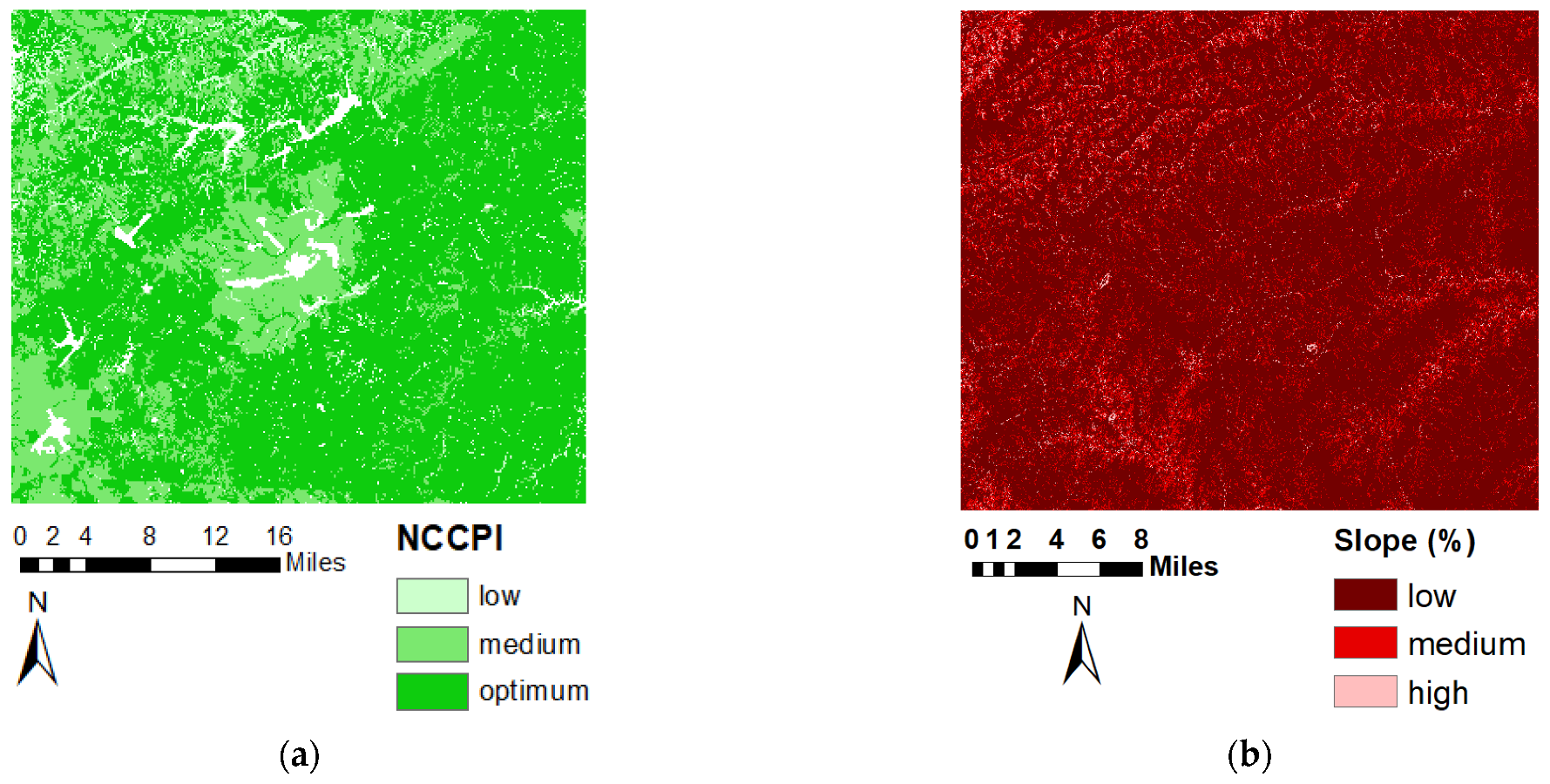
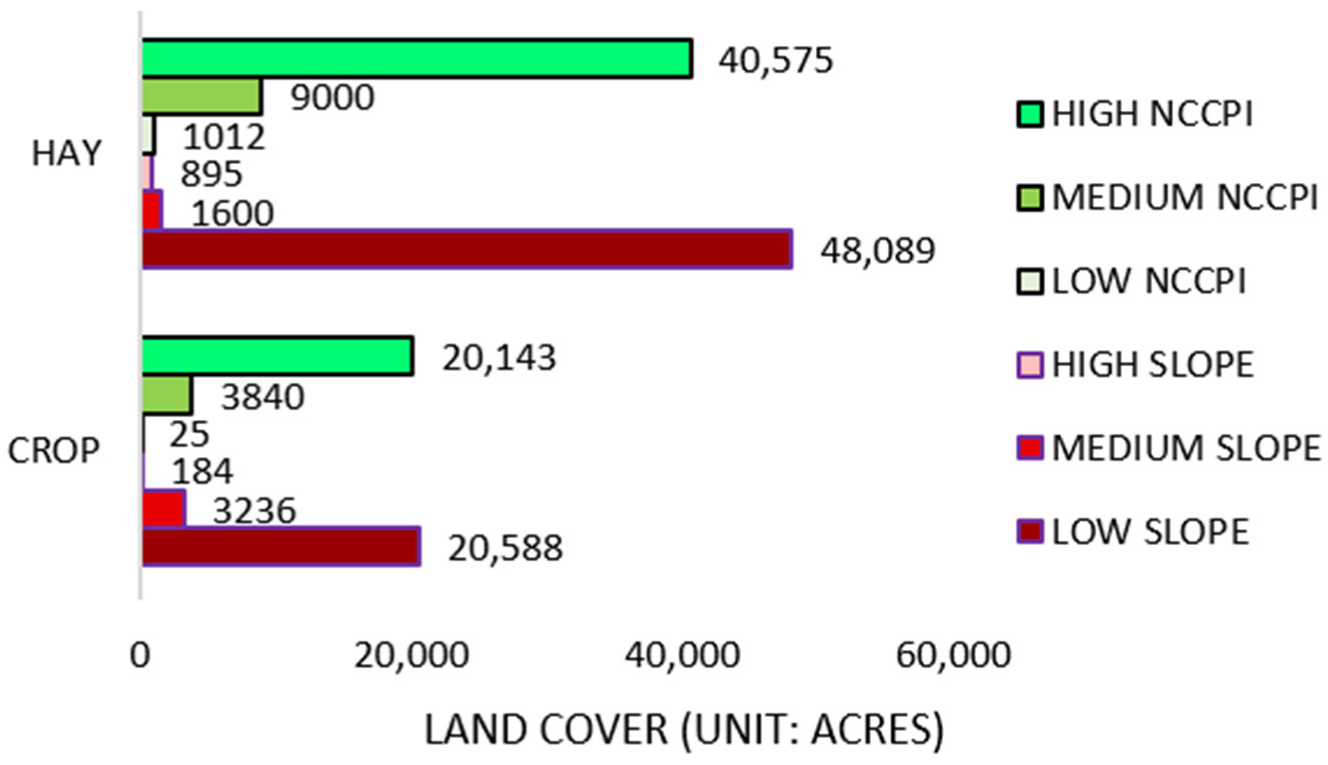
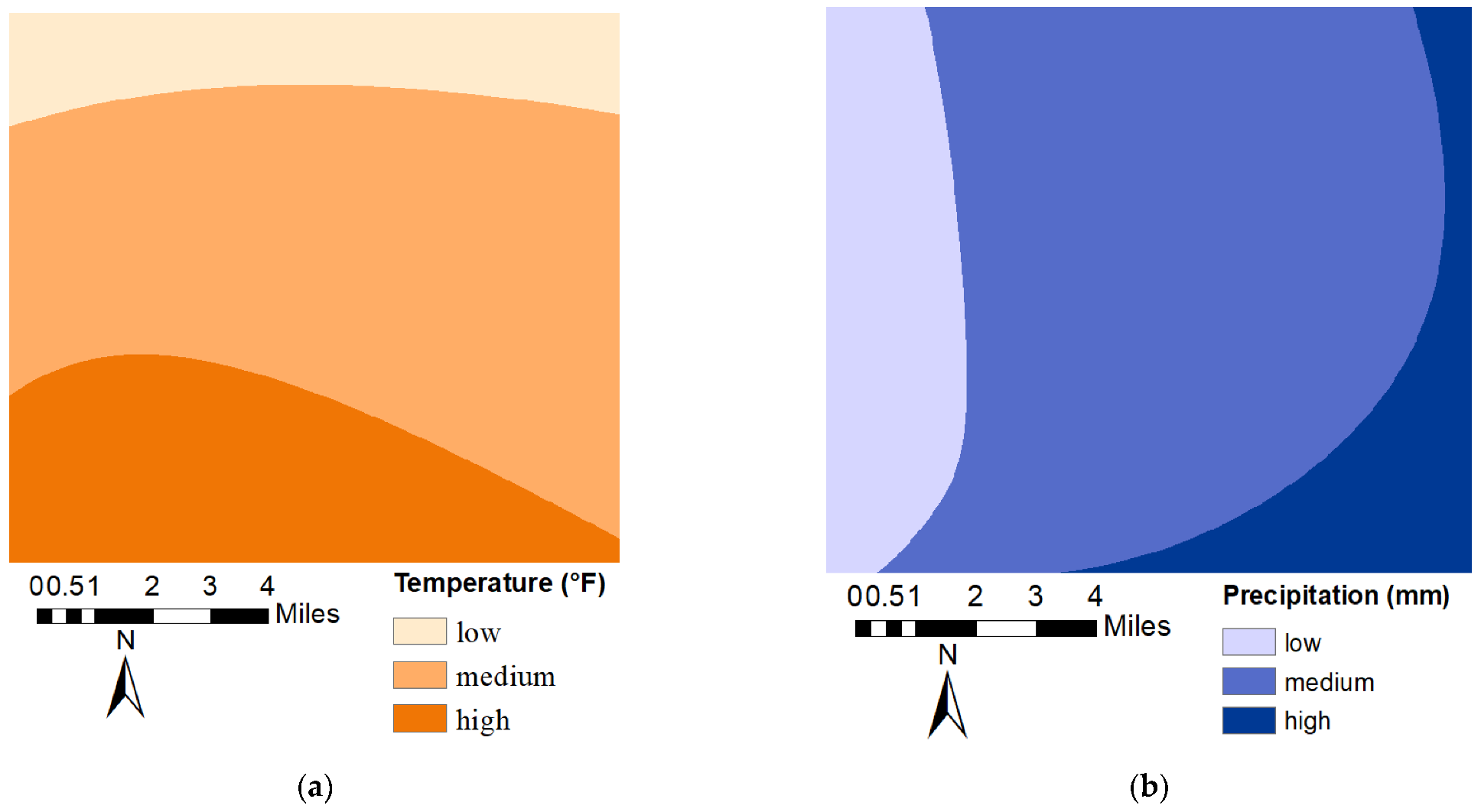

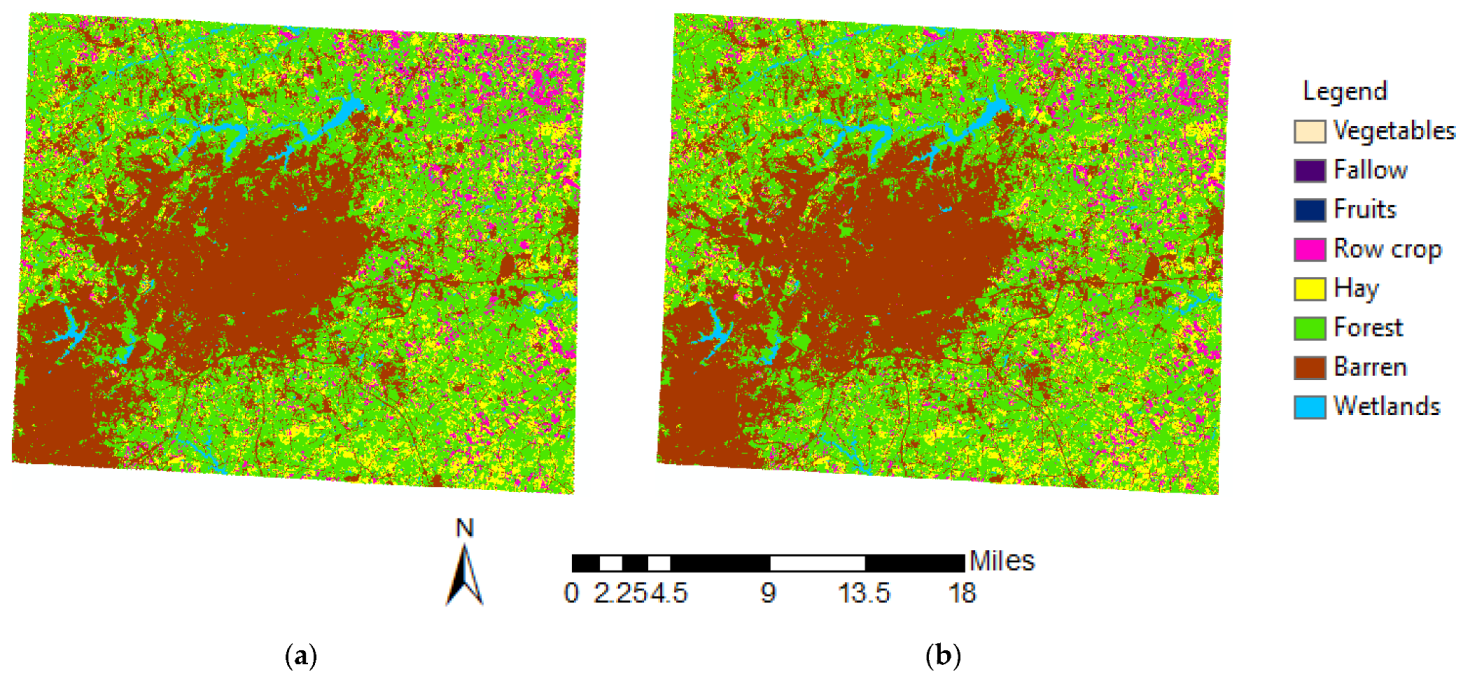
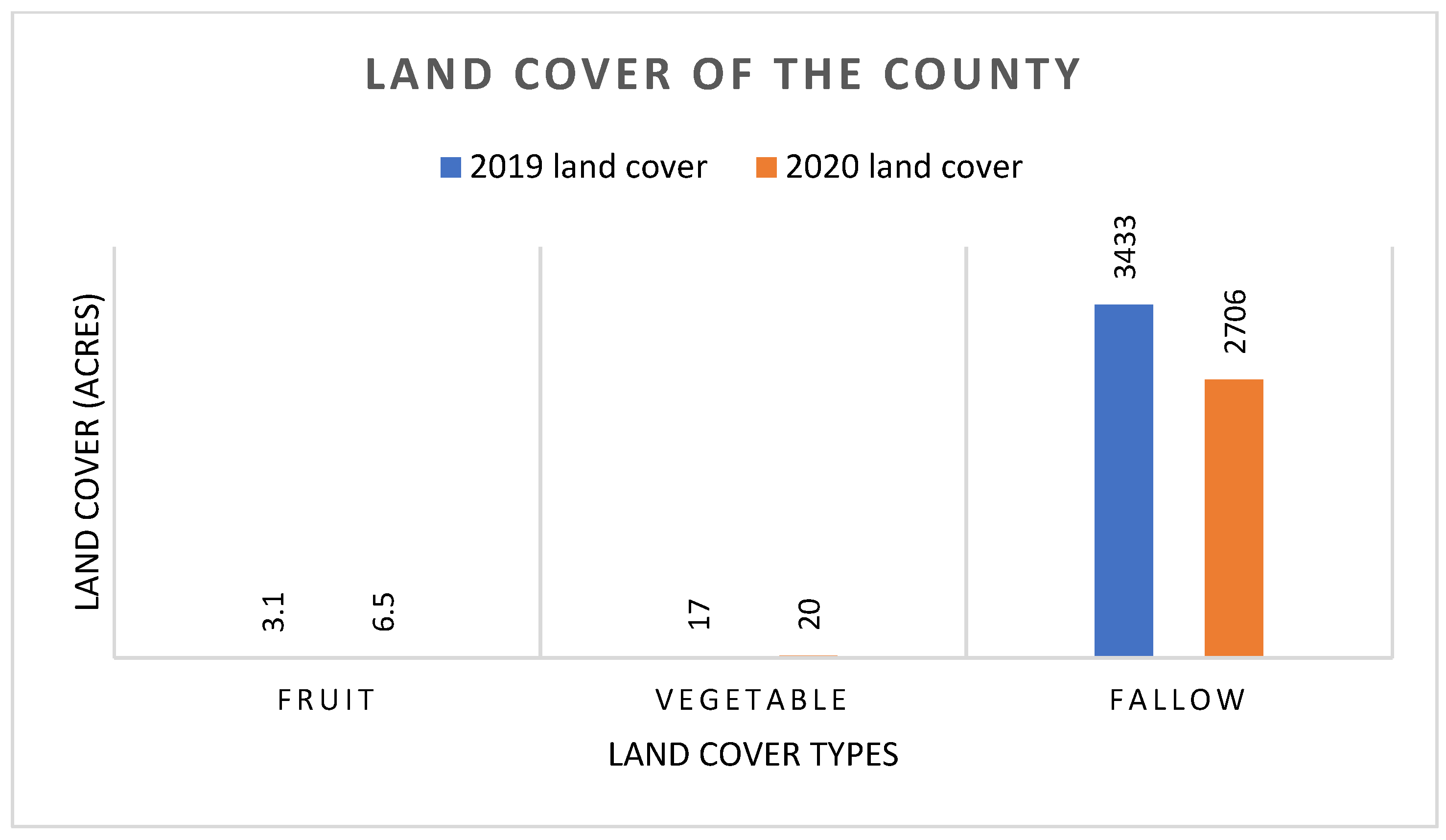


Publisher’s Note: MDPI stays neutral with regard to jurisdictional claims in published maps and institutional affiliations. |
© 2022 by the authors. Licensee MDPI, Basel, Switzerland. This article is an open access article distributed under the terms and conditions of the Creative Commons Attribution (CC BY) license (https://creativecommons.org/licenses/by/4.0/).
Share and Cite
Gebrehiwot, A.A.; Hashemi-Beni, L.; Kurkalova, L.A.; Liang, C.L.; Jha, M.K. Using ABM to Study the Potential of Land Use Change for Mitigation of Food Deserts. Sustainability 2022, 14, 9715. https://doi.org/10.3390/su14159715
Gebrehiwot AA, Hashemi-Beni L, Kurkalova LA, Liang CL, Jha MK. Using ABM to Study the Potential of Land Use Change for Mitigation of Food Deserts. Sustainability. 2022; 14(15):9715. https://doi.org/10.3390/su14159715
Chicago/Turabian StyleGebrehiwot, Asmamaw A., Leila Hashemi-Beni, Lyubov A. Kurkalova, Chyi L. Liang, and Manoj K. Jha. 2022. "Using ABM to Study the Potential of Land Use Change for Mitigation of Food Deserts" Sustainability 14, no. 15: 9715. https://doi.org/10.3390/su14159715
APA StyleGebrehiwot, A. A., Hashemi-Beni, L., Kurkalova, L. A., Liang, C. L., & Jha, M. K. (2022). Using ABM to Study the Potential of Land Use Change for Mitigation of Food Deserts. Sustainability, 14(15), 9715. https://doi.org/10.3390/su14159715








